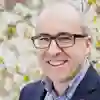A research project you helped us fund in 2013 allowed Dr Laura Soucek to develop a new treatment she was working on, proving that it was ready for clinical trials. The treatment, called Omomyc, works by attacking a protein in cancer cells called MYC and shutting down the cells ability to grow and divide. For decades, people had been saying this approach to treating cancer was impossible. Some even called MYC the 'undruggable' target in cancer. Defying the sceptics, and beating the odds, Dr Soucek's perseverance paid off and the first patients were treated with Omomyc on clinical trials that started in 2021.
We had some hints that Omomyc could be developed into a drug, but it was clearly still a high-risk project, which required a funding agency brave enough to believe in us and the potential rewards. Worldwide Cancer Research was exactly that - they recognised the value and potential of what we were doing and provided us the resources we needed for our project to take off. We will always be grateful for that.

There is a molecule in our cells that drives tumour growth in 70% of all cancers. It’s called MYC, and for decades scientists have been searching for a way to develop drugs that could treat a wide range of cancers by targeting this molecule.
For a long time, achieving this seemed impossible. MYC is a protein that exists deep within the cell, at its very core – the nucleus – and has the kind of shape that makes it difficult to target with drugs.
Because MYC is central to so many different mechanisms within the cell, scientists feared that blocking it might cause catastrophic side effects. They referred to MYC as ‘drugging the undruggable’.
But where most saw insurmountable challenges and difficulties, some saw a huge opportunity. Dr Laura Soucek, a cancer researcher based at the Vall d'Hebron Institute of Oncology in Spain, has dedicated her career to solving this problem. In the early 2000s, her early research led to the development of a treatment, called Omomyc, that she was confident would be able to target and inactivate MYC, preventing cancer cells from dividing.

During these early experiments, Dr Soucek and her team were able to show that Omomyc had a dramatic impact on cancer cells, and only mild, well-tolerated, completely reversible side effects on normal tissues.
Emboldened by these promising results, Dr Soucek moved to San Francisco for a one-year fellowship, in which she hoped to further test Omomyc as a cancer treatment. One year turned into ten, and it became clear that Omomyc held real promise as a potential treatment.
Following Dr Soucek's move to the Vall d’Hebron Institute of Oncology in Barcelona, she was able to show that Omomyc could shrink tumours grown from human cancer cells in mice – the gold standard for determining if a drug has the potential to go on to clinical trials in people.
These results were exciting, but there was one important problem – all these studies used Omomyc in a form of treatment called gene therapy. And while gene therapy is a promising and exciting area of research, it’s not something that can be done in patients yet.
The project funded by Worldwide Cancer Research and the support of our Curestarters was crucial, allowing Dr Soucek to continue discovering more about Omomyc and putting the team in an ideal position to take Omomyc into clinical trials. The project delivered the proof of principle that Omomyc represented a promising new treatment strategy for lung cancer, as well as potentially many other types of cancer.

The resources provided by Worldwide Cancer Research allowed Dr Soucek and her team to produce important preliminary data, which eventually formed the bases for other prestigious international grant applications that continued to support the project.
That research is now heading towards having a real benefit for cancer patients. In 2019, Dr Soucek was awarded 2 million Euros from the EU Horizon 2020 Research and Innovation programme to take Omomyc into clinical trials, which started in 2021, recruiting patients with lung, breast and bowel cancer.
If successful, Omomyc has the potential to be used in many types of cancer and the approach Laura used to 'drug the undruggable' could be extended to other treatment targets that have been considered impossible to reach.
By becoming a Curestarter, you can help us continue to support more bright ideas like Dr Soucek's - allowing us to potentially uncover new knowledge about cancer that could lead to lifesaving new ways to prevent, diagnose, and treat cancer.

Donate now & become a Curestarter
Be part of a united effort to stop lives being cut short by cancer.



